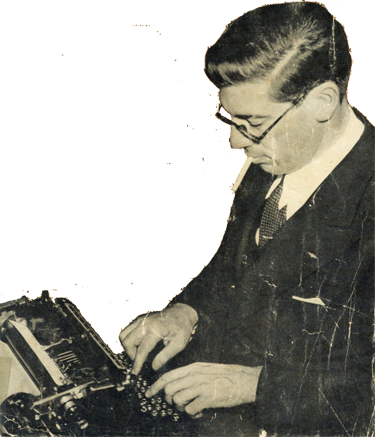BOOKS
Paul Gallico: Biography Overdue
September 2, 2018
In 2018 one might connect someone 50 years or older to author Paul Gallico by reminding the >50-year-old of The Snow Goose. In the early 1970s this story about an artist, a girl and a way-off-course Canadian goose set on the eve of World War II was broadcast a couple Christmas shopping seasons on the Hallmark Hall of Fame. The Snow Goose was also rebroadcast outside the Hall several times.
Another Gallico story brought to us by Hallmark was A Small Miracle, a remake of Never Take No For An Answer, about an Italian boy with a sick donkey who believes that St. Francis can heal the ailing ass. This only got one showing as did an ABC made-for-TV movie, Gallico's The Story of Silent Night, broadcast on Christmas night, 1968.
Around those years of The Snow Goose repeats and of Paul Gallico's last storytelling hurrah, The Poseidon Adventure, I became aware of authorship and that one who practiced that art was named Paul Gallico. It fascinated me that a person could live by writing stories of which movies and TV shows were made.
Gallico's books were the first grown-up fiction I read: Coronation, The Foolish Immortals, The Abandoned. It was a thrill to find another Gallico at a flea market for two to four bits. I bet no other kid got close to reading Love, Let Me Not Hunger, "grown-up" on the verge of being adult!
Paul Gallico was no P.G. Wodehouse when it came to style and technique, but he was also no Wodehouse in telling the same two stories over and over again.
In Gallico's taleweaving the reader met a Brit family thrilled to have tickets to Queen Elizabeth II's coronation, traveled to the birthing of the State of Israel, became stranded in Spain with a dinky English circus, evangelized Ireland wth St. Patrick.
Cats: Gallico wrote at least four books about felines such as Thomasina filmed by Disney. He was truly a pioneer of the cat book. He also blazed the trail for old-lady books with his Mrs. Harris series about a London cleaning woman. Mrs 'Arris was enlivened on screen by Angela Lansbury (Who else?). Gallico's story about romance via puppets blossomed into the movie Lili and the musical Carnival.
Paul Gallico was no P.G. Wodehouse when it came to style and technique, but he was also no Wodehouse in telling the same two stories over and over again.
I think I had read a dozen Gallico books and had moved on to other authors by the July 1976 day I came home, sunburned and tired from golf, to hear my Mom announce, "Paul Gallico died."
In a few-seconds obituary on the news that evening, Harry Reasoner described Gallico as a predecessor of George Plimpton, a sportswriter who tried professional athletics and then reported on the experience.
Forty-two Julys later, when eBay has replaced all the old flea markets between DC and Gettysburg, I ordered and read a couple of the Gallico books that I didn't get to long ago.
Reading Farewell To Sport, I wondered if a biography of Paul Gallico has ever been written since his death. To my surprise it has not. The most extensive life story of the sportswriter reborn as a storyteller is the Wikipedia entry.
That may be because Gallico was never a member of the lit'ry crowd. He wrote stories that the middle class liked, not stories about how stupid and awful the middle class is. By his own admission he wrote for fun and profit, likely for mostly the latter. "I'm a rotten novelist" he told New York magazine, "I'm not even literary. I just like to tell stories and all my books tell stories...."
I believe that in one of Gallico's biographical blurbs on a dust-jacket, he states, "I write good."
Of all Gallico's books published over 35 years, only The Snow Goose won an award and received praise, if faint, from a leading critic who is now forgotten.
I suspect that the first 40 years of Paul Gallico's life would make more interesting autobiography than the second. By the time he reached his median, Gallico had been married twice.
Having obtained a Reno divorce (reason: cruelty) from his 17-year-old second wife, he left a successful sportswriting career, following Damon Runyon and Ring Lardner into writing fiction.
Not only did he leave sportswriting, he left the United States, settling in southwest England.
As war clouds rose and darkened, the native New Yorker returned to the U.S. married to a Hungarian baroness with show business ambitions. The 1950s again found Gallico living in Europe, finally settling in Antibes France.
Another Nevada divorce was eventually sequelled by another baroness, a Lichtensteiner who served as a lady-in-waiting to Princess Grace of Monaco. His issue were two sons from his first wife, one being the late Bob Gallico who became a celebrity broadcaster in Ireland.
Although he had bid farewell to sport, Gallico's first big seller as a bookwriter was a sports book: Lou Gehrig - Pride of the Yankees, released in 1942 simultaneously with the movie starring Gary Cooper as the "Iron Horse."
Pride of The Yankees (1) was typical biography of the time, not very deep, with traces of Horatio Alger: shy, unathletic mama's boy forced to support his family becomes, by the grace of his grit, successor to Babe Ruth. He marries his love. Then comes the "tragic mystery" in his muscles which he meets by declaring himself to be "the luckiest man on the face of de oith."


